Black plants are fascinating to me. The color of death and dying is the antithesis of the green life of the garden. The black-ness of an eggplant (aubergine for you Brits) never ceases to amaze me, I truly could marvel at its blackness and lose minutes in the garden.
I have always been fascinated with black plants – I even used them extensively in a show garden I designed for Hampton Court Palace Flower Show in 2002. (You’ve asked for pictures… and I promise to someday show you, but they are on a defunct computer, and quite a project to retrieve). But for now – here are a bunch of Black plants that I have grown and known and loved over my career.
I’ve organized them with perennials and annuals first and then followed by trees and shrubs for bigger impact.
27 Beautiful Black Plants that will add contrast and intrigue to your Garden
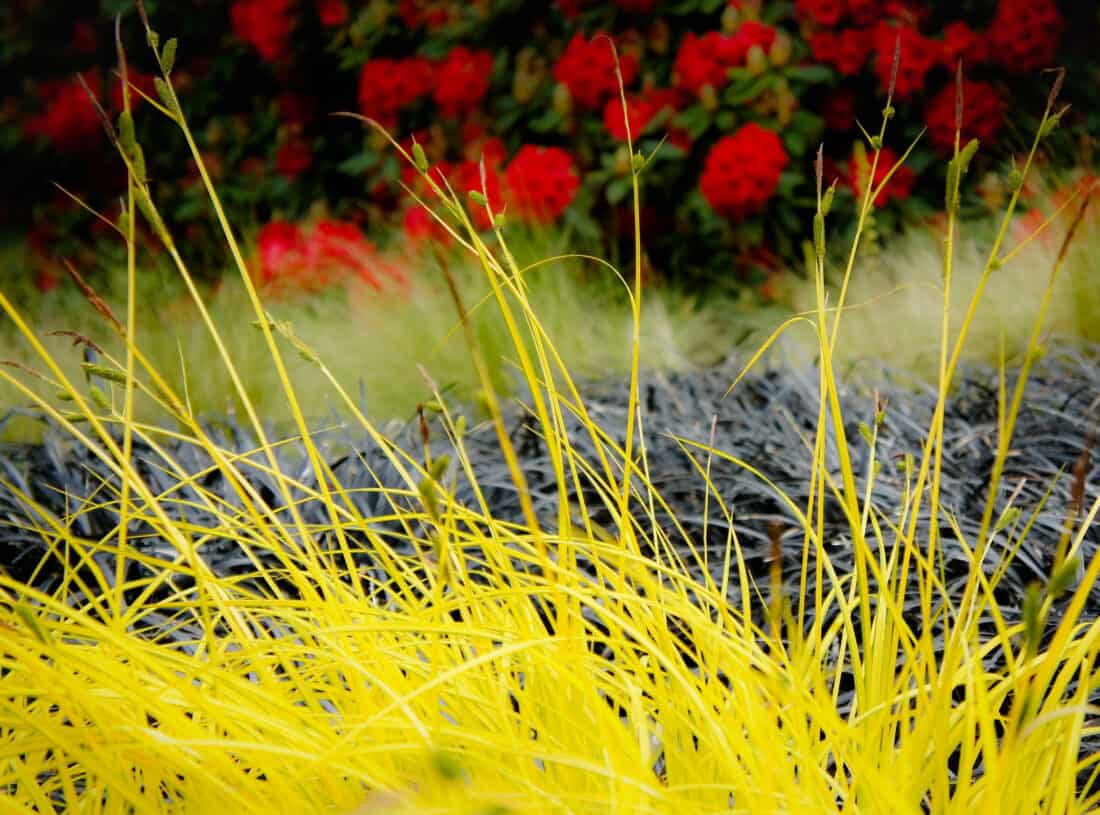

1. Black Mondo Grass (Ophiopogon planiscapus):
Black Mondo Grass (Ophiopogon planiscapus ‘Nigrescens’) is a low-growing, grass-like plant with almost black foliage, it’s excellent for ground cover or edging. This eye-catching perennial features slender, arching leaves create a striking contrast against other foliage.
Purchase: Black mondo grass
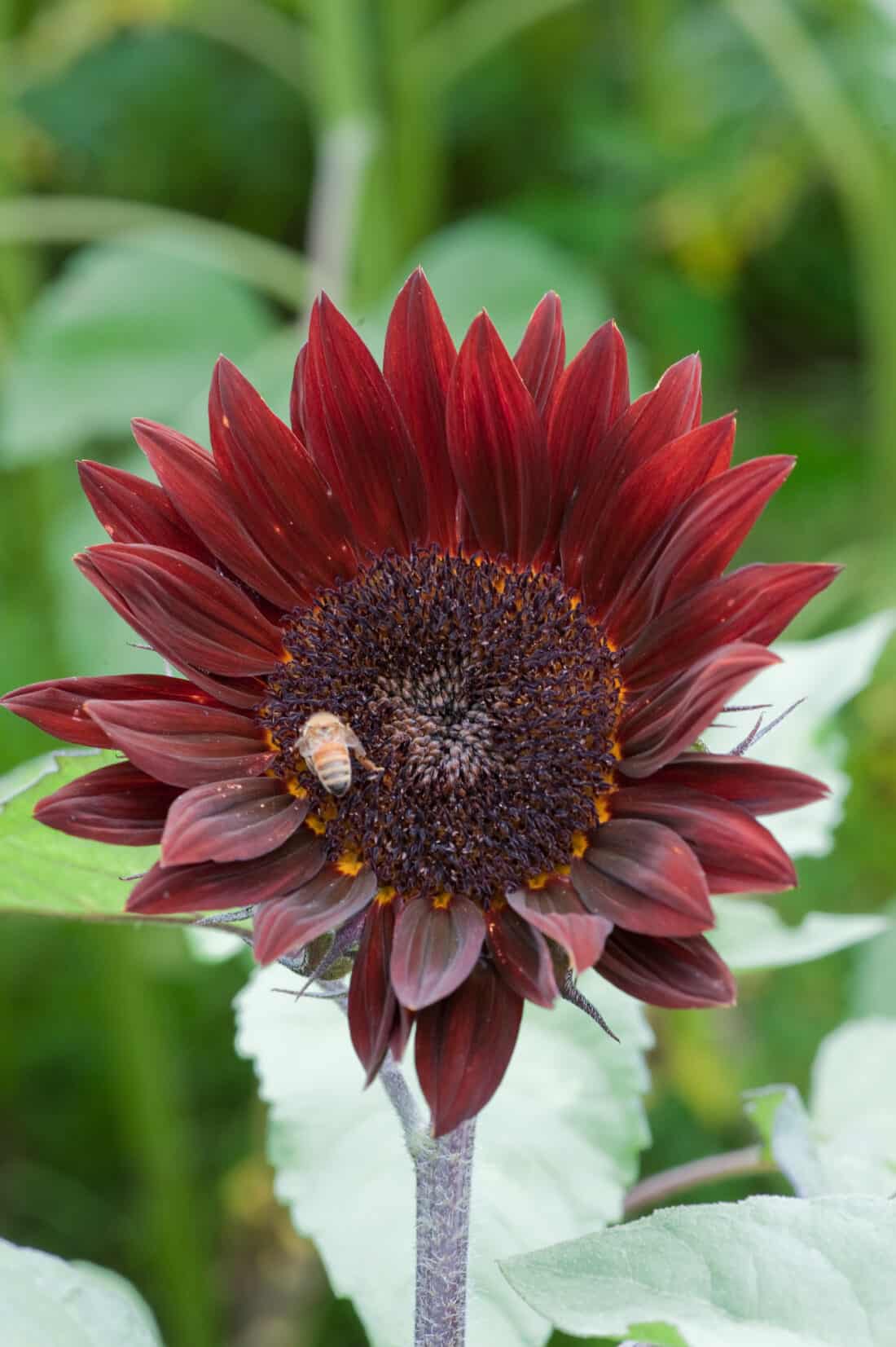
2. Chocolate Sunflowers
Not really “Chocolate”, they are known for their rich, dark, and velvety brown to burgundy petals. Additionally, they provide valuable nectar for pollinators and make excellent cut flowers, adding both a touch of elegance and novelty.
Purchase: Chocolate Cherry Sunflower Seeds.
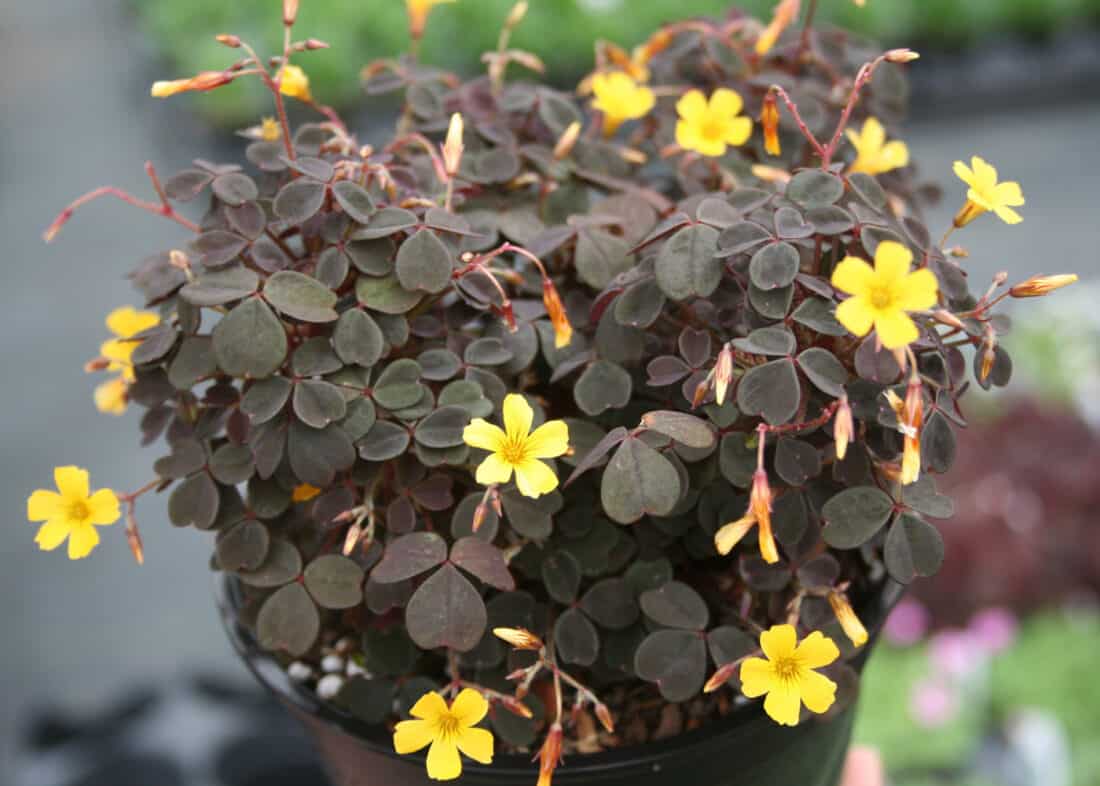
3. Zinfandel shamrock – Black Oxalis
The flowers may be dainty, but the yellow blossoms shine brightly with the dark purple/black foliage background of this Zinfandel shamrock. Known botanically as Oxalis vulcanicola, these oxalis will brighten shady areas in the landscape or offer year-round enjoyment inside the house.
Purchase: Plum Crazy Oxalis or
Alternatively : Purple Shamrock Tubers

4. The Watchman Black Hollyhocks
Also known as Alcea rosea ‘The Watchman,’ are a striking and bold addition to garden landscapes. These tall, stately perennials showcase deep, nearly black, burgundy-hued flowers on tall spikes, Their vertical growth and robust stature make them excellent choices for adding height and structure to flower beds or borders.
Purchase: Alcea Rosea Seeds
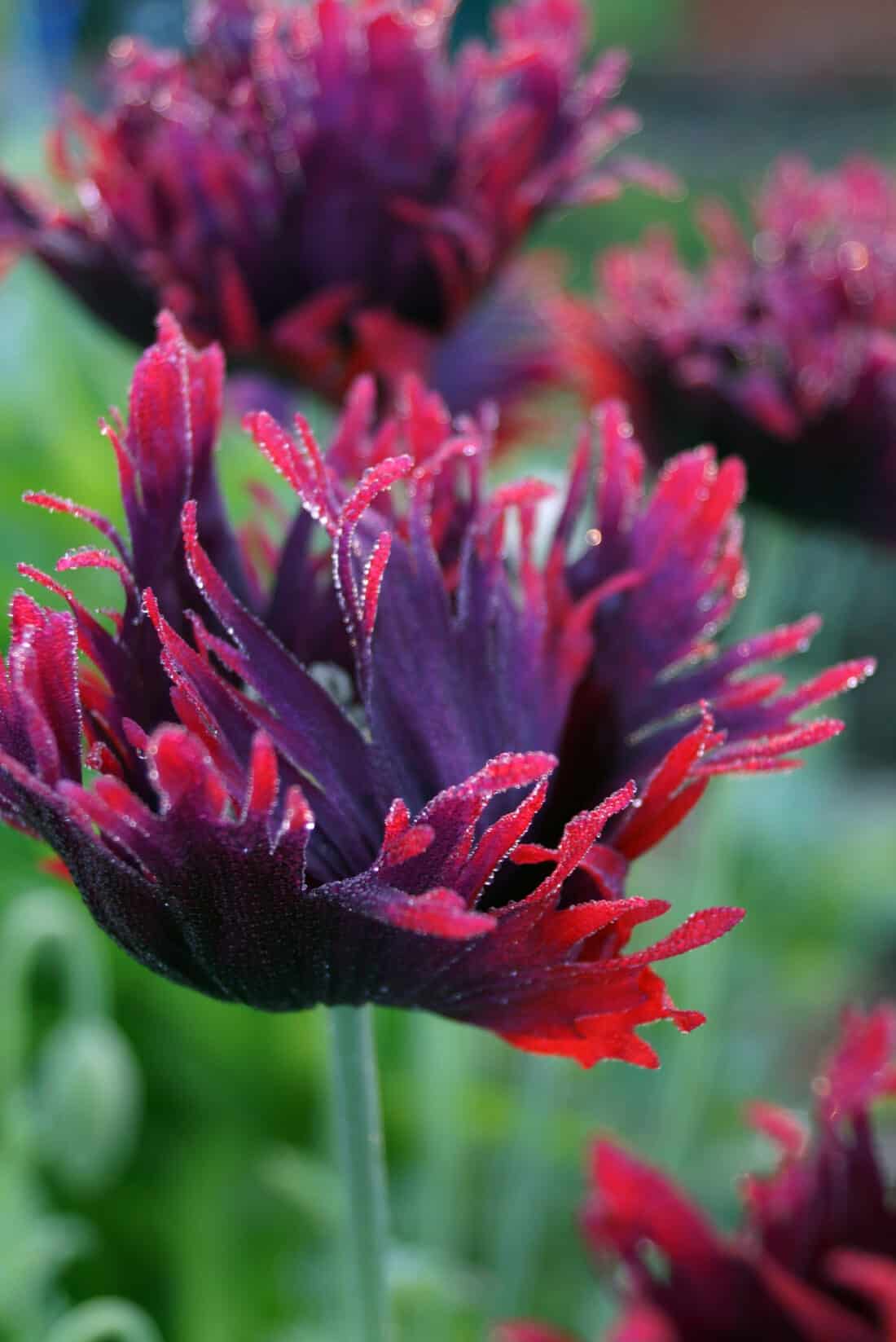
5. Drama Queen Papaver somniferum Annual Poppy
The Drama Queen Papaver somniferum is a true diva in the garden world. This poppy variety boasts dramatic large, deeply fringed petals in shades of rich, velvety purple.
Purchase Drama Queen poppies or Purchase similar: Lauren’s Grape Somniferum Poppy (the prettiest black plant imo)
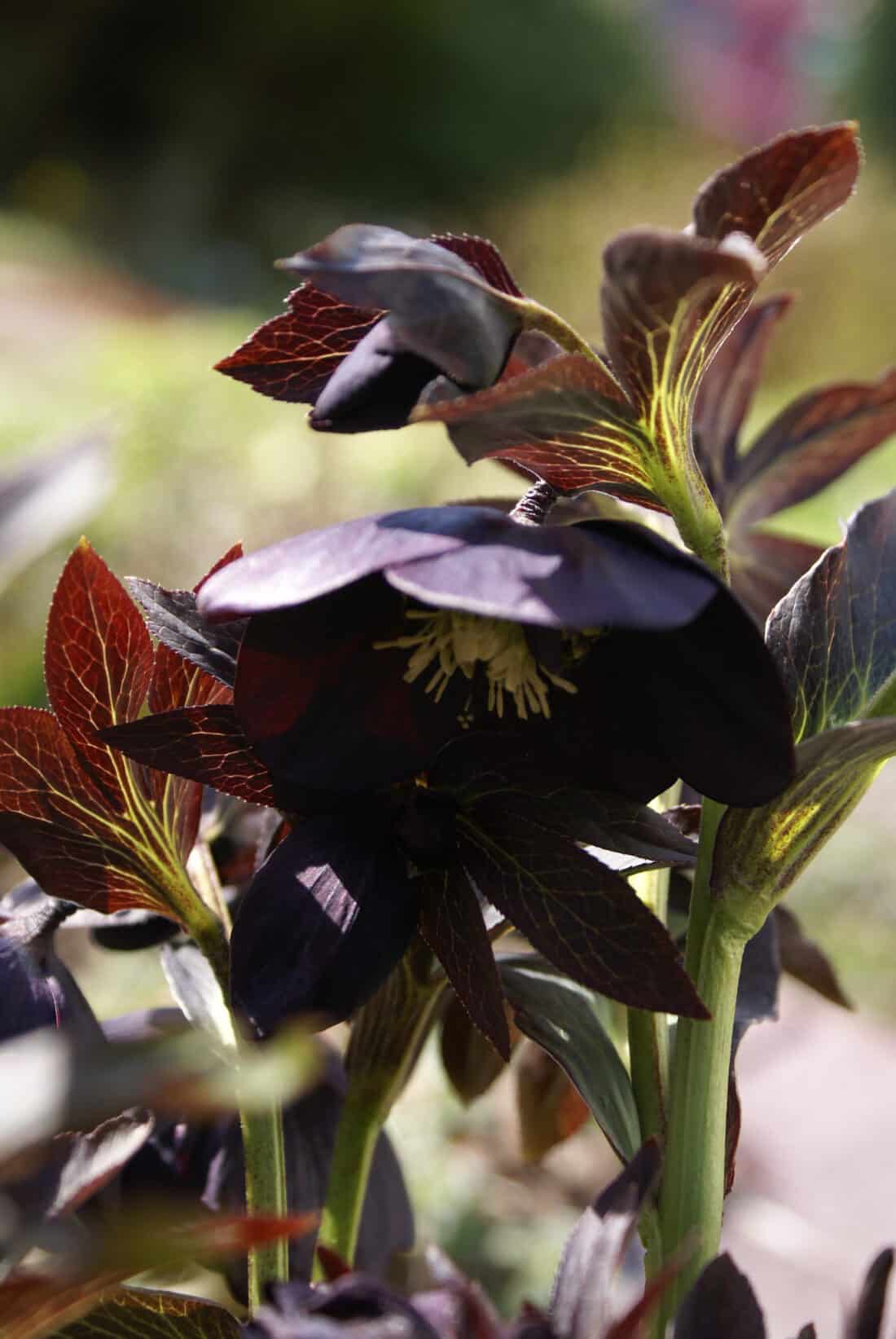
6. Black Hellebore
Hellebores, also known as Lenten Roses or Christmas Roses, bloom early, often flowering during the late winter or early spring when little else is in bloom. These hardy and long-lived perennials come in various species and cultivars, offering a diverse range of flower colors, from whites and pinks to deep purples and near-blacks.
Their downward-facing, cup-shaped flowers that nod gracefully. Hellebores thrive in shade to part-shade conditions, making them excellent choices for woodland gardens or as groundcover beneath trees and shrubs. hellebores are low-maintenance nature and deer resistant.
Purchase similar : Winter Plum Double Lenten Rose
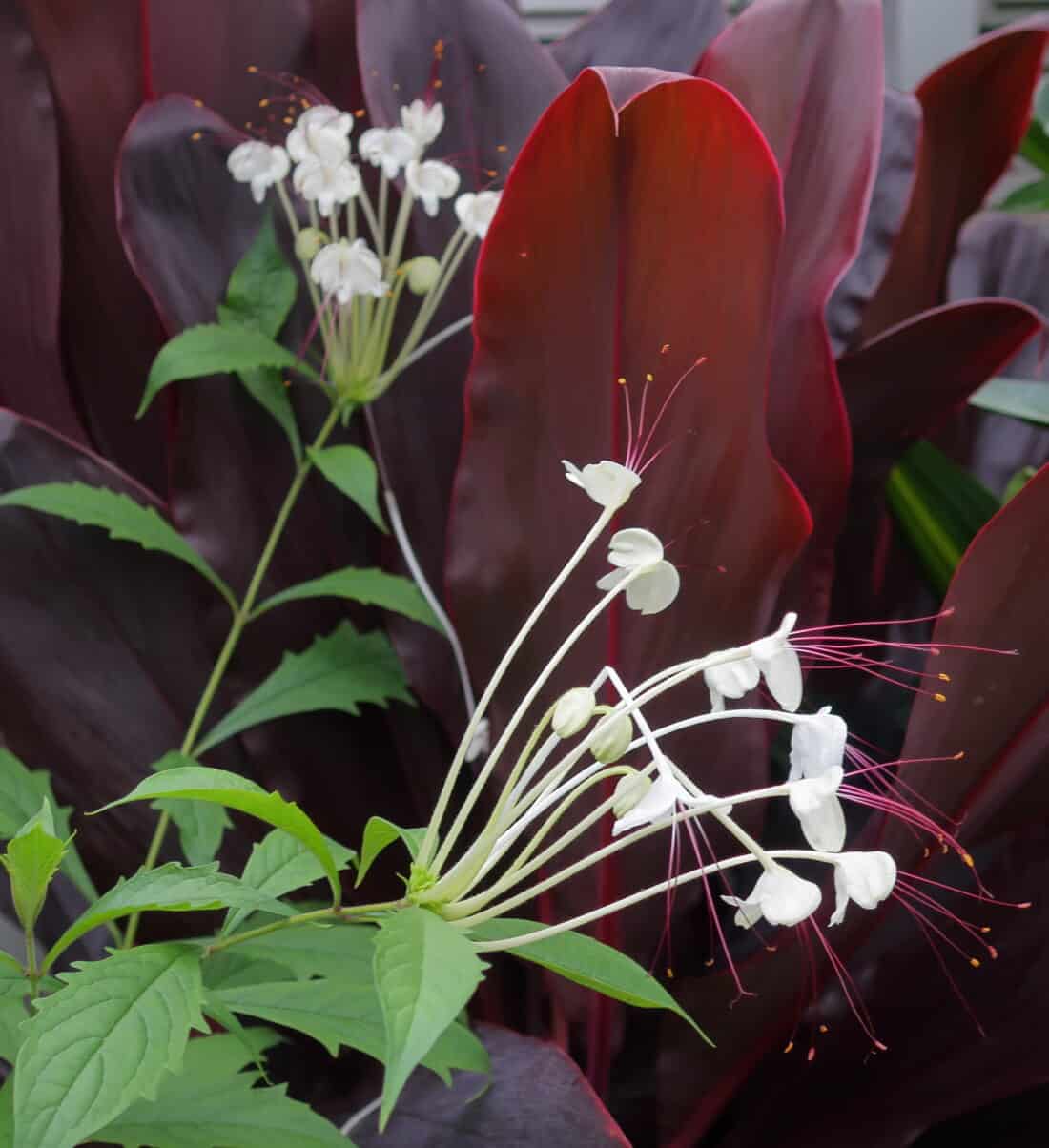
7. Cordyline fruticosa ‘Black Magic’
Corydline are striking and dramatic plants that can add a touch of exotic elegance to your garden or indoor spaces. As a tropical plant, they do well as houseplants as well. This tropical evergreen features long, arching leaves that are dark burgundy to nearly black in color, providing a bold contrast against green foliage in your landscape.
Plant Purchase similar: Corydeline florida Flamingo
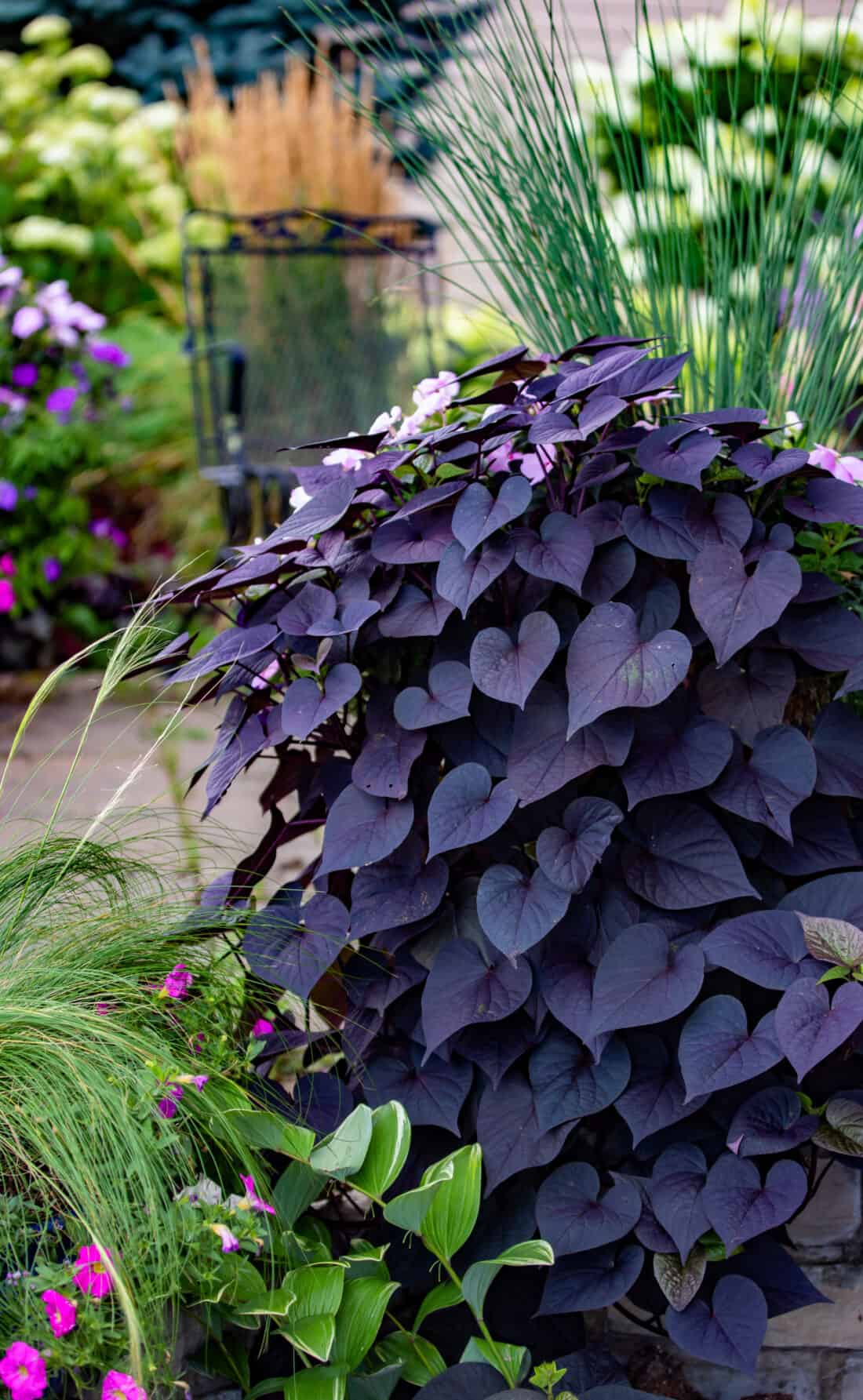
8. Black sweet potato vine – Ipomea
Ipomoea ‘Jet Black’ is a captivating cultivar of the morning glory vine. This annual plant has velvety, jet-black leaves. It can be grown on trellises, fences, or arbors, or left to drape over the side of a container. Its grows fast and can easily overtake other plants, so you sometimes need to prune i tback or plant it in ints own container.
Purchase: Jet Black Sweet Potato vine Ipomea. or Sweet Caroline Sweetheart Ipomea
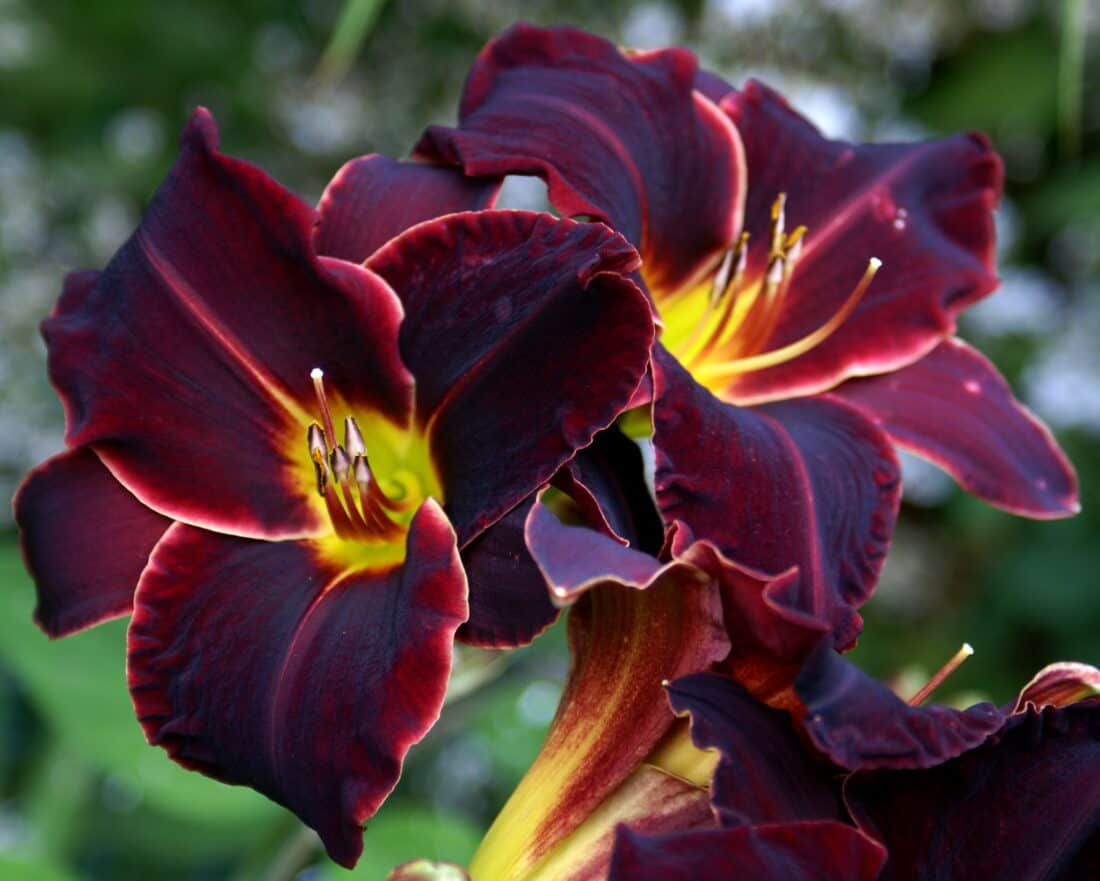
9. Black Daylily
Choose Daylilies because they are one of the easiest plants to grow in almost any garden. they can be ubiquitous as a group but the Black Daylilies are special – known for their deep, velvety black or near-black blossoms. Daylilies are very hardy and low-maintenance nature, making them an excellent choice for both novice and experienced gardeners.
Purchase similar: Applique Daylily
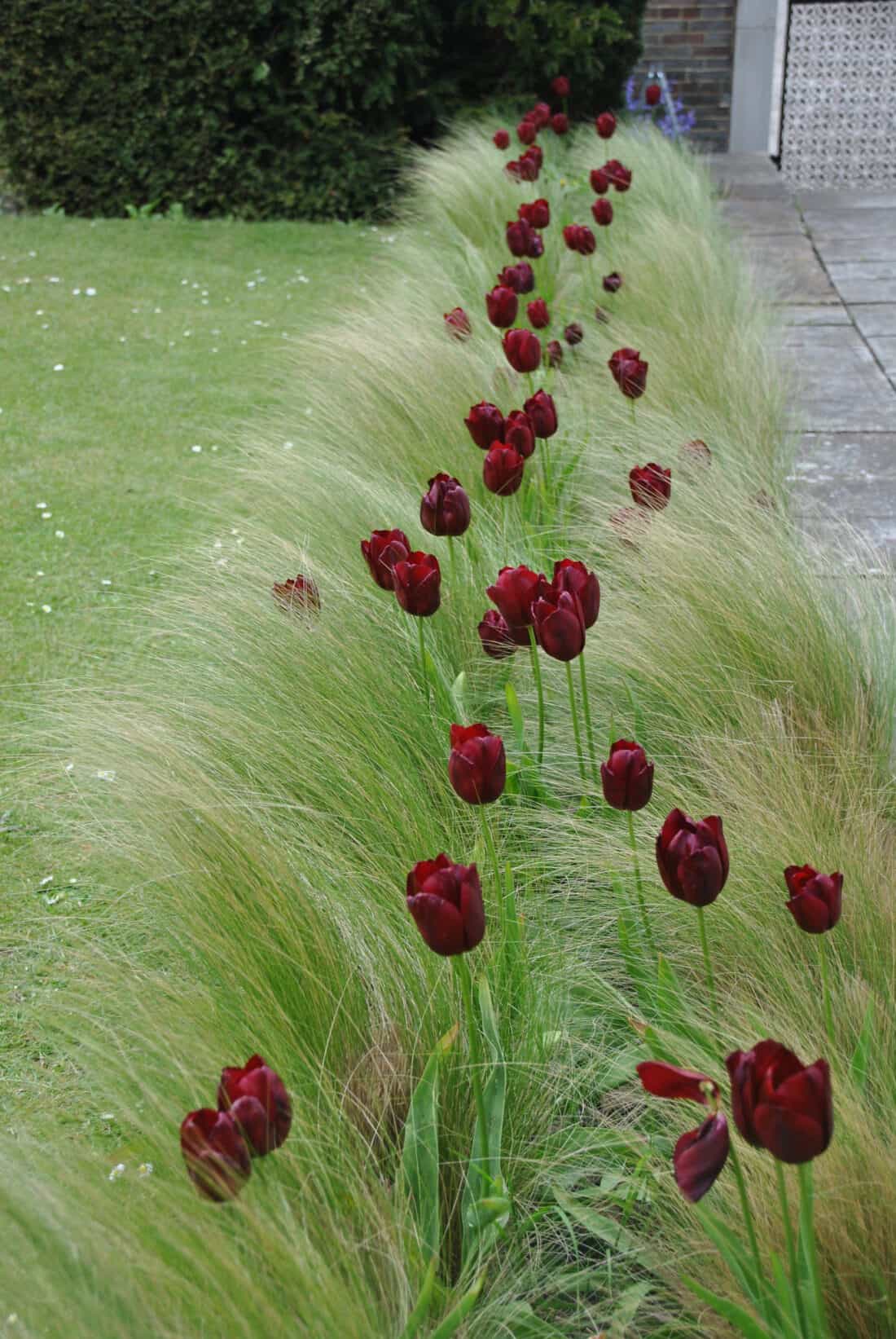
10. Black Tulips
Black Tulips are a symbol of elegance and mystery in the world of flowering bulbs. While true black tulips are exceedingly rare, there are several varieties and cultivars that come close to achieving this deep, dark hue. Here are some notable varieties:
- ‘Queen of Night’ (Tulipa ‘Queen of Night’): This is one of the most famous black tulips. Its velvety, near-black blooms are almost indistinguishable from true black in low light.
- ‘Black Parrot’ (Tulipa ‘Black Parrot’): This variety offers a unique twist with fringed petals that resemble the feathers of a parrot. The flowers are a rich, dark burgundy.
- ‘Black Hero’ (Tulipa ‘Black Hero’): These tulips produce deep maroon to blackish blooms and are known for their durability.
- ‘Paul Scherer’ (Tulipa ‘Paul Scherer’): A newer addition to the world of dark tulips, ‘Paul Scherer’ boasts almost black flowers with a glossy sheen.
- ‘Black Diamond’ (Tulipa ‘Black Diamond’): This variety showcases deep maroon petals with a dark center, creating a jewel-like effect.
- ‘La Belle Epoque’ (Tulipa ‘La Belle Epoque’): These tulips have a dusky purple color with a smoky, vintage appearance.
Purchase Black Parrot tulip Bulbs
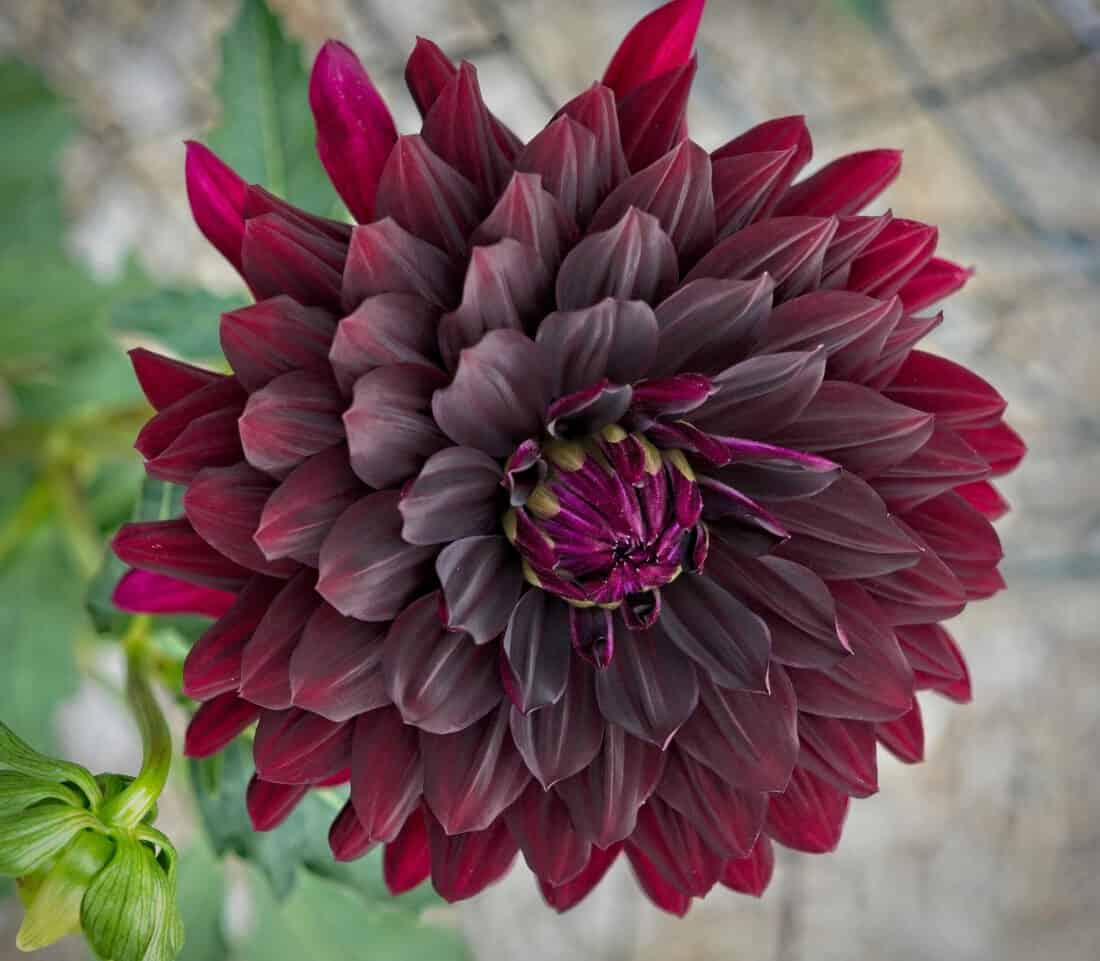
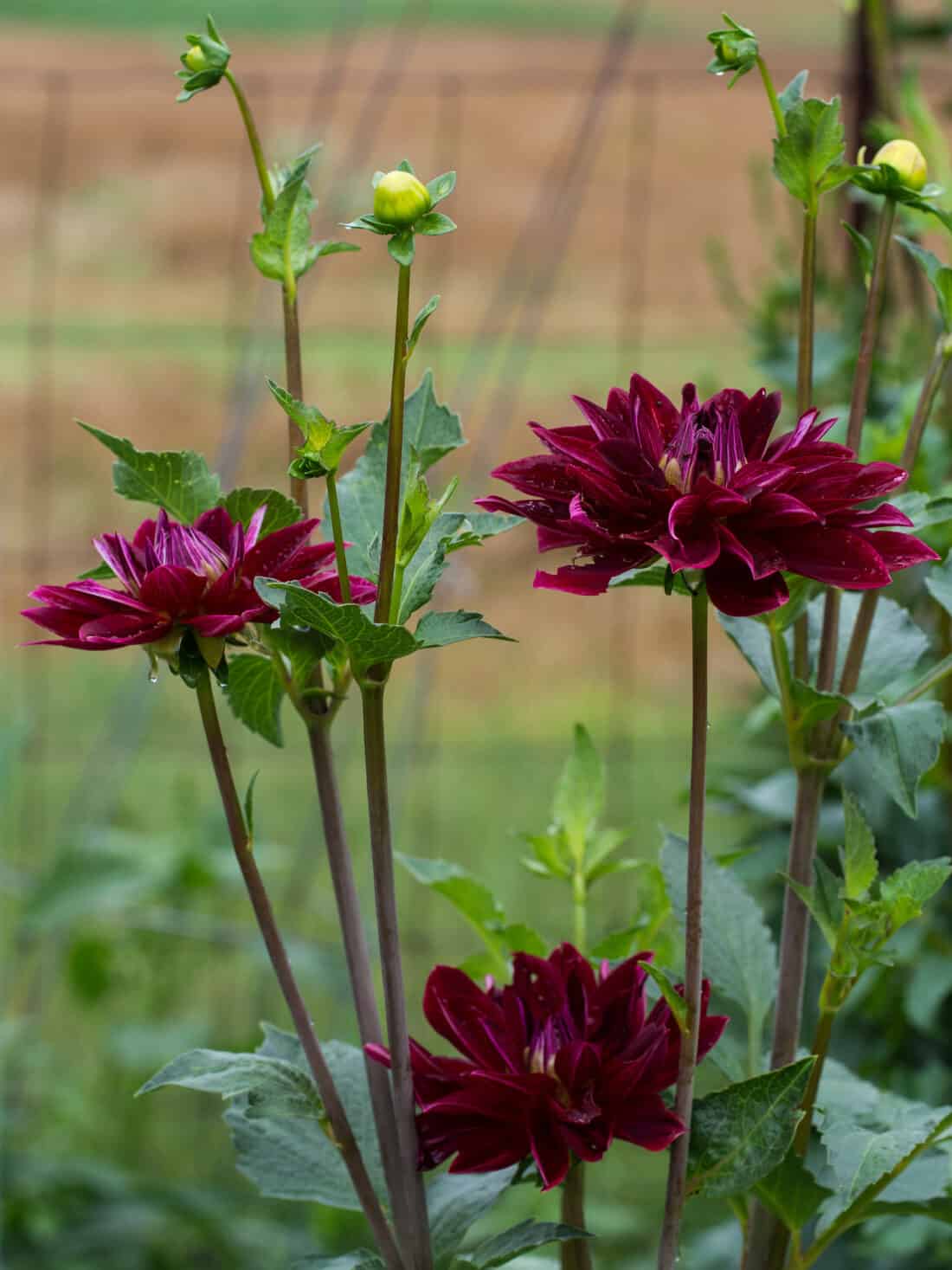
11. Black Dahlias – With Black Flowers
Black Dahlias are known for their mysterious and dramatic presence in gardens. While true black flowers are rare in the plant world, there are several Dahlia varieties and cultivars that come close to achieving this deep, dark hue. Here are some noteworthy Black Dahlia varieties:
- ‘Black Satin’ (Dahlia ‘Black Satin’): This Dahlia variety is known for its deep burgundy to near-black, velvety petals. Its dark, dramatic blooms add elegance to garden designs.
- ‘Arabian Night’ (Dahlia ‘Arabian Night’): With its deep maroon petals, ‘Arabian Night’ creates a rich and captivating presence in the garden.
- ‘Black Beauty’ (Dahlia ‘Black Beauty’): This variety boasts almost black, dark red blooms with a touch of mystery.
- ‘Chat Noir’ (Dahlia ‘Chat Noir’): True to its name, ‘Chat Noir’ features dark, nearly black blossoms with a hint of red at the base of its petals.
- ‘Moorplace’ (Dahlia ‘Moorplace’): These Dahlias exhibit deep burgundy to dark maroon flowers.
- ‘Black Jack’ (Dahlia ‘Black Jack’): A relatively newer introduction, ‘Black Jack’ showcases deep red to almost black blooms.
- ‘Lenora Macob’ (Dahlia ‘Lenora Macob’): This striking Dahlia variety features dark burgundy to nearly black petals.
- ‘Holly Hill’ (Dahlia ‘Holly Hill’): ‘Holly Hill’ Dahlias showcase deep, velvety dark red to blackish blooms.
While these Dahlias may not be truly black, their dark and velvety hues make them stand out and add a sense of mystery and sophistication to flower beds, borders, and floral arrangements.
Purchase similar: Black Wizard Cactus Dahlia
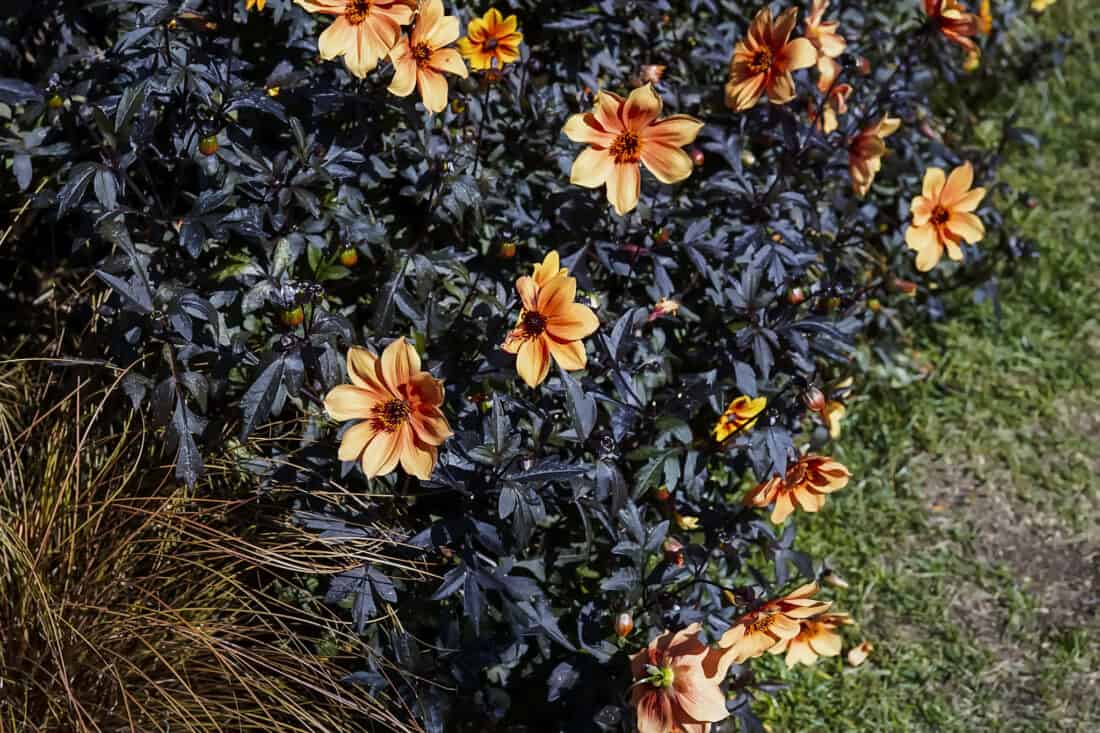
13. Black Dahlias – With Black Foliage
Dahlias known for their dark or nearly black foliage:
- ‘Bishop of Llandaff’ (Dahlia ‘Bishop of Llandaff’): This popular Dahlia variety features dark, bronze-black foliage that provides a striking contrast to its vibrant red flowers.
- ‘Black Jack’ (Dahlia ‘Black Jack’): In addition to its dark red to almost black blooms, ‘Black Jack’ has dark foliage that enhances its overall mystique.
- ‘Black Narcissus’ (Dahlia ‘Black Narcissus’): This Dahlia variety showcases deep burgundy to nearly black leaves, complementing its dark red flowers.
- ‘Moorplace’ (Dahlia ‘Moorplace’): Known for its dark foliage, ‘Moorplace’ Dahlias have deep burgundy to dark maroon flowers.
- ‘Melissa Anna Marijke’ (Dahlia ‘Melissa Anna Marijke’): This Dahlia variety features dark, almost black foliage, providing an elegant backdrop for its rich purple colored blooms.
- ‘Yellow Hammer’ (Dahlia ‘Yellow Hammer’): While it features bright yellow flowers, ‘Yellow Hammer’ Dahlia is valued for its nearly black foliage, creating a striking contrast.
These Dahlias with dark or nearly black foliage not only offer stunning blooms but also add a touch of drama and elegance to garden landscapes.

14. Black calyces Salvia guaranitica “Black and Blue”
Salvia guaranitica ‘Black and Blue’ is a striking perennial known for its vibrant blue flowers and its black calyces. The calyces are the protective coverings of the flower buds and add a dramatic and contrasting element to the plant’s appearance.
This Salvia variety is not only visually appealing but also attracts pollinators like hummingbirds and butterflies with its nectar-rich blooms.
Purchase similar: Salvia Guaranitica Black and Blue
More Black plant inspiration
There are so many interesting varieties of black plants you could ad to your garden – (too many to list!).
There is a worthwhile book for more ideas called , Black Plants: 75 Striking Choices for the Garden by Paul Bonine. It’s a small volume, but full of beautiful photography of these lovely specimens. A great choice for inspiration or even a coffee table book….to fascinate even the non horticulturally minded among us.
Checkout this post for How to Use Black Plants in your Planting Designs :How to use the Seductive Qualities of Black Flowers in your Garden
And this post suggests a variety of companion plants and plant pairings that dramatically feature Black plants
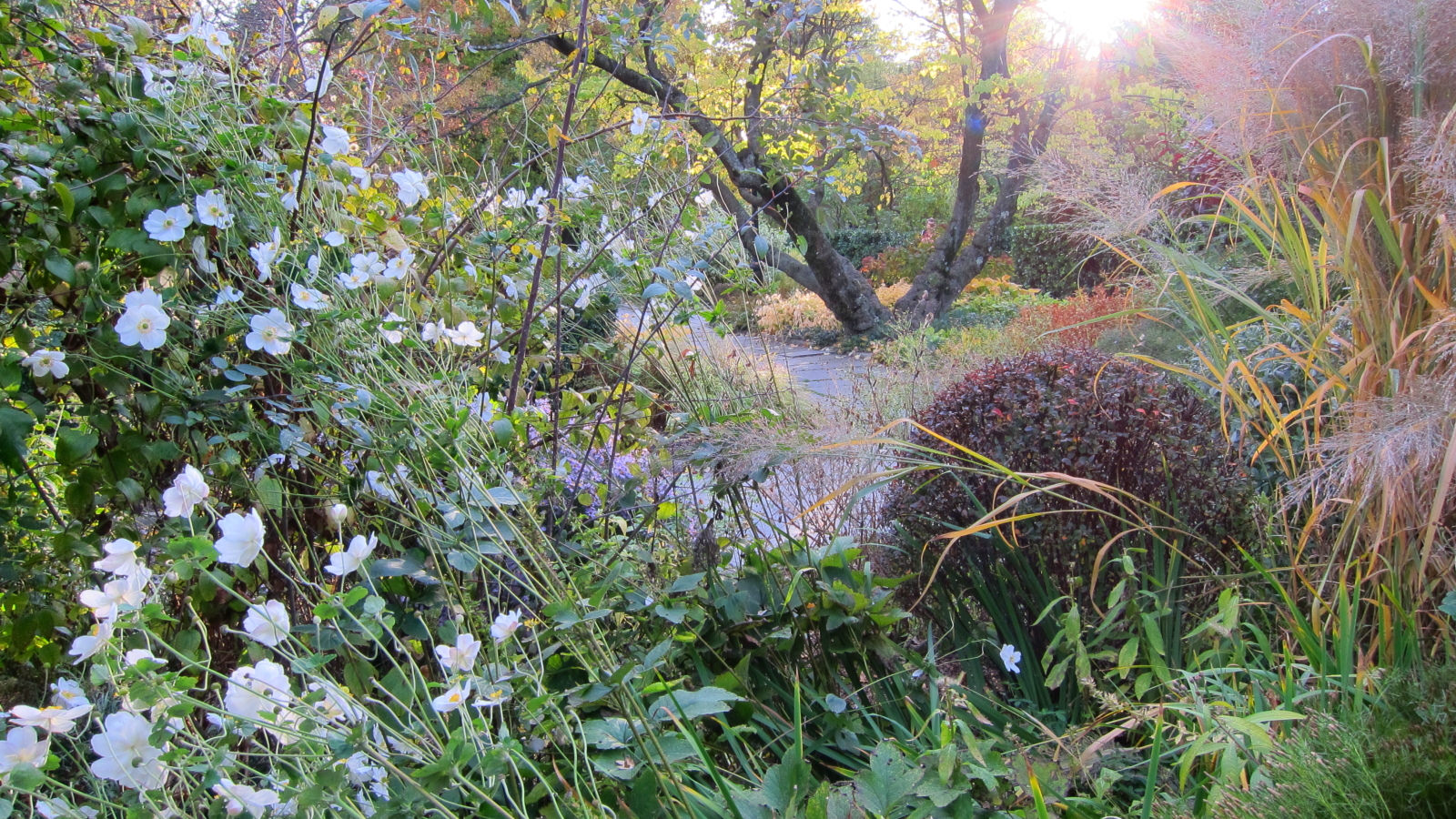
Black and Dark-leaved Trees and Shrubs:
In garden design, trees and shrubs with dark or black leaves can play a pivotal role in creating striking contrasts and adding a sense of drama to the landscape. These plants offer a rich tapestry of colors and textures that can be both visually arresting and emotionally evocative. Here’s a list of some of my favorite trees and shrubs with dark or black leaves that are exceptional additions to a garden:

15. Frosted Purple Barberry
Frost Purple Barberry (Berberis x mentorensis ‘Purple Frost’) is a captivating shrub known for its deep purple foliage, adorned with a delicate silver-gray margin, creating a frosty and ethereal effect. This variegated coloration adds a touch of elegance and intrigue to garden landscapes.
Red-Leaf Japanese Barberry (Berberis thunbergii ‘Atropurpurea’) is a purplish-red leaved variety that can be used to create beautiful hedges and borders. Check to make sure it is not invasive where you live before planting it. Alternate plant: Berberis ‘Crimson Pygmy’ (a dark red-leaf barberry).
Purchase similar : Sunjoy mini maroon barberry.
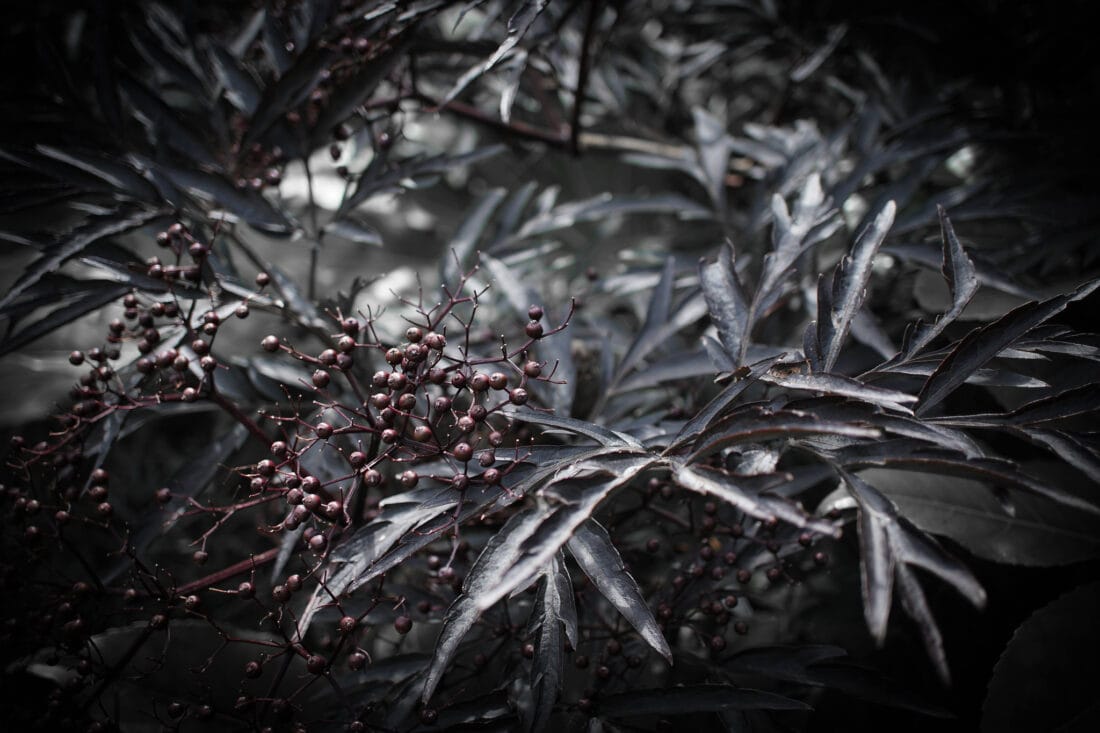
16. Sambucus Nigra ‘Black Lace’
Sambucus nigra ‘Black Lace’ is a standout cultivar of elderberry renowned for its finely cut, dark purple-black foliage. This deciduous shrub’s striking leaves create a dramatic backdrop for its clusters of pink flowers (that are often made into a cordial) in late spring, followed by dark edible berries in late summer.
Purchase : Sambucus Nigra Black Lace.
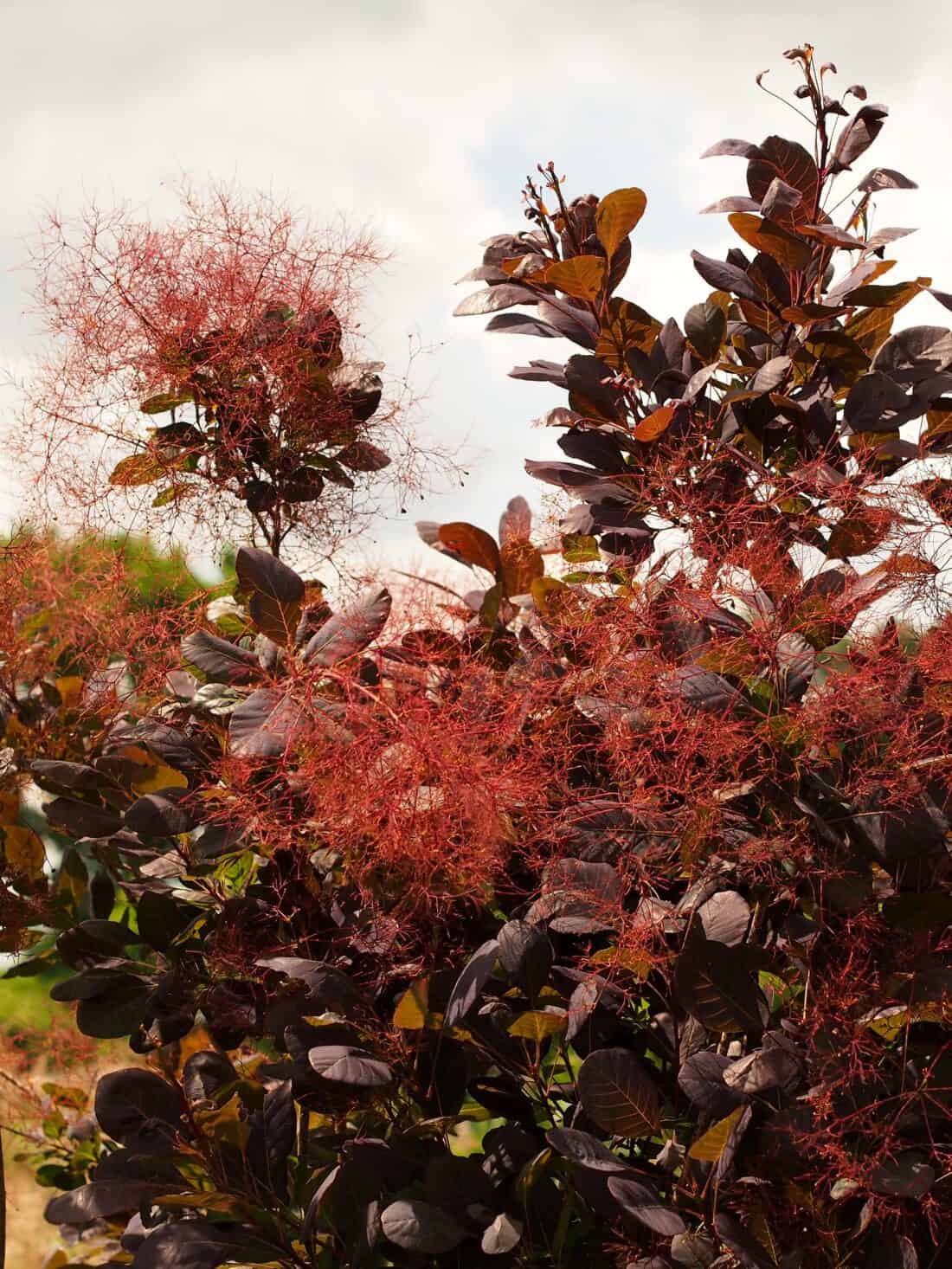
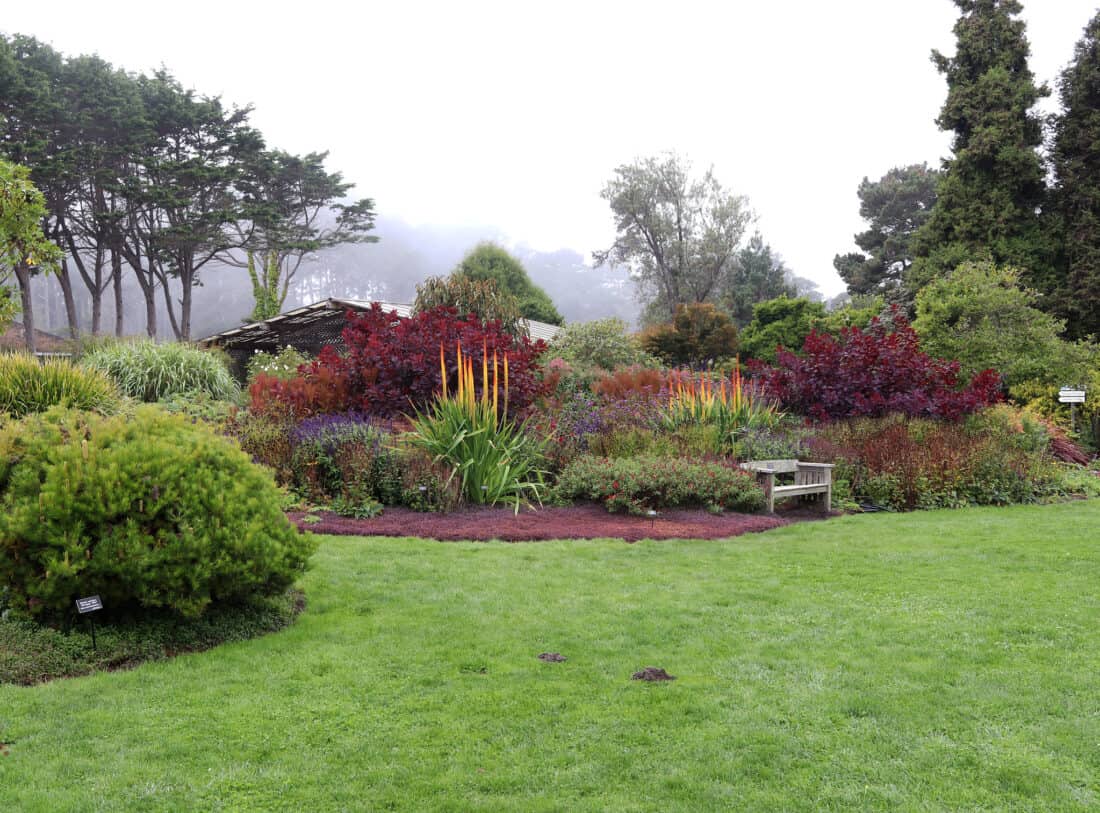
17. Purple Smoke Bush (Cotinus coggygria ‘Royal Purple’):
The purple smoke bush (Cotinus coggygria ‘Royal Purple’) is a deciduous shrub (in my own garden, it is more of a tree) that boasts deep purple leaves and smoky, airy plumes of flowers.
The huge flower plumes are fun to use in a big dramatic floral arrangements.
Purchase: Winecraft Black Smoke Bush (Cotinus)

18. Japanese Maple (Acer palmatum ‘Bloodgood’):
Japanese maple is probably the first thing most home gardeners think of when they start imagining dark plants in their garden. The Japanese maple marketing has been EFFECTIVE for many years and these trees are widely known and loved.
Renowned for its striking dark red foliage, it’s a classic choice for adding elegance and structure. There are however many hundreds of other ornamental Japanese maple varieties that are equally as interesting (or more-so – because they are not quite so ubiquitous) that are worth seeking out.
Explore Maple Ridge Nursery or Mr. Maple for a huge selection of options.
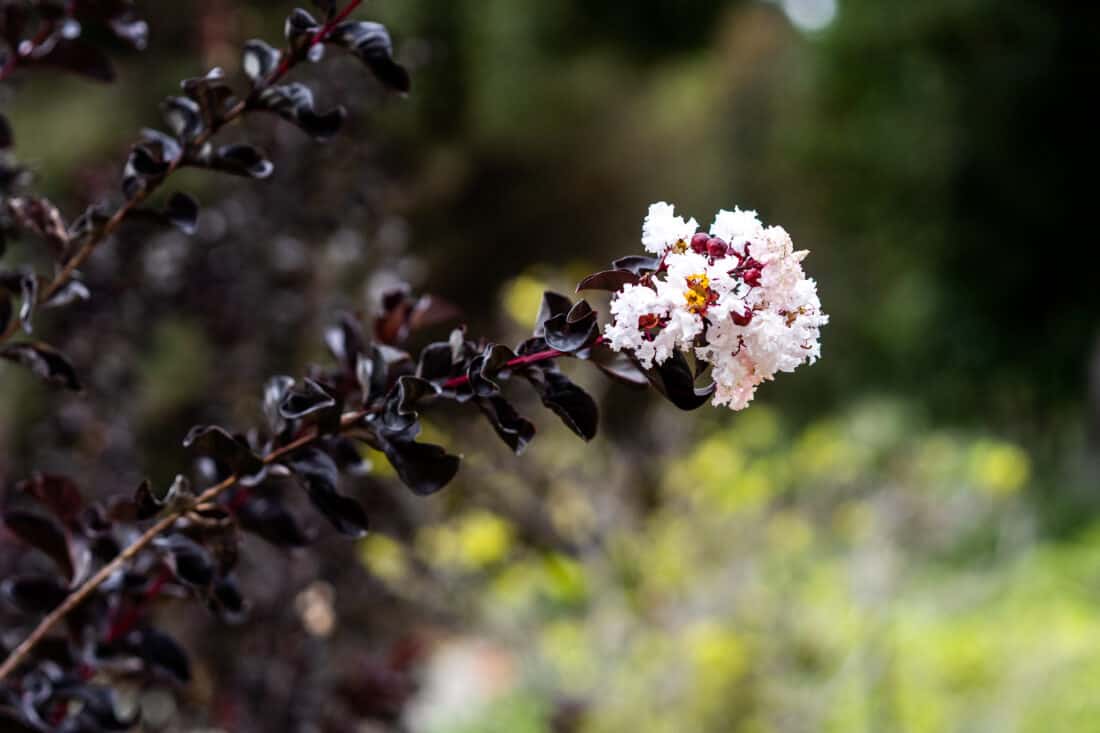
19. Black Diamond Crape Myrtle (Lagerstroemia indica ‘Black Diamond’):
With its deep burgundy to almost black leaves and vibrant blooms, it brings a bold touch to the garden. there are varieties that bloom in pinks as well as white (see above). Black diamond crape myrtle is not hardy in northern climates, so check your zone before planting.
Purchase: Black Diamond Shell Pink Crape Myrtle
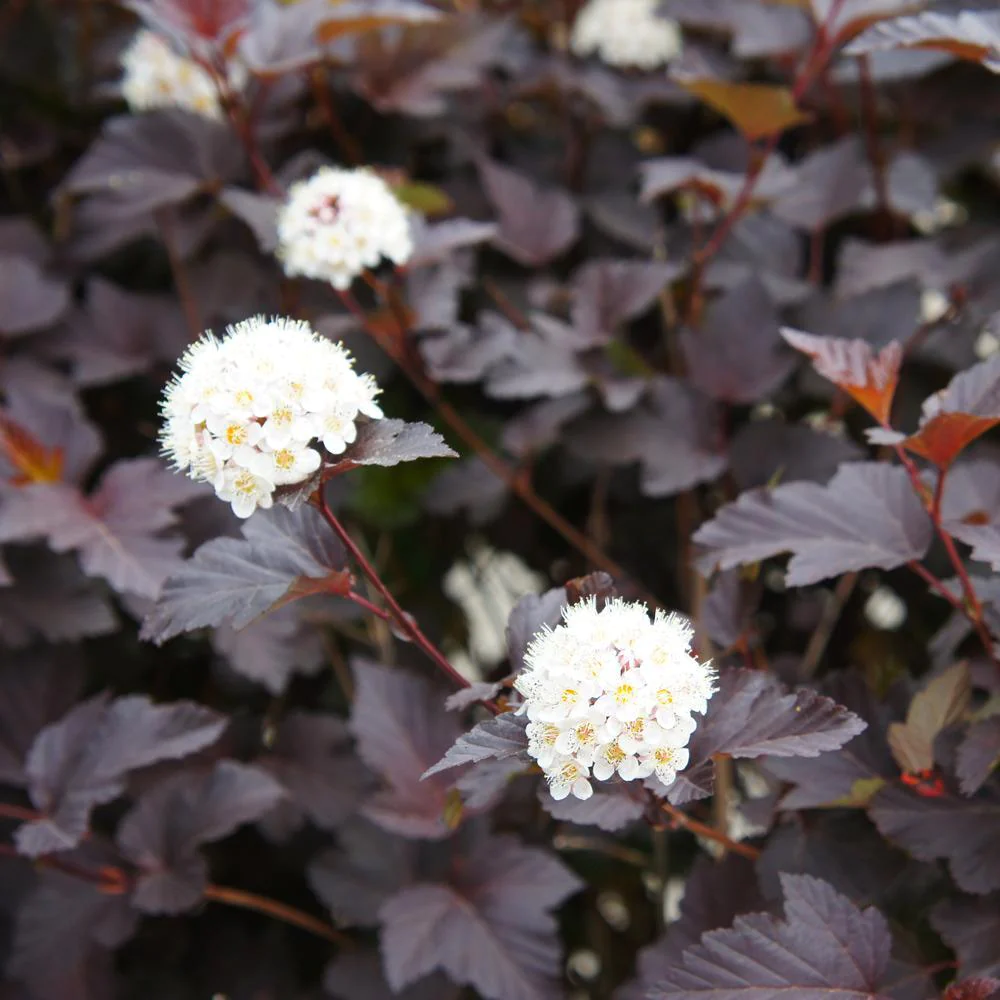
20. Coppertina Ninebark (Physocarpus opulifolius ‘Mindia’):
While not entirely black, Ninebark comes in many varieties that have foliage varying from deep bronze-brown to deep burgundy. The arching stems. of these shrubs are a great backdrop plant or hedge plant to add a rich, dark element to the garden.
Purchase: Panther Ninebark
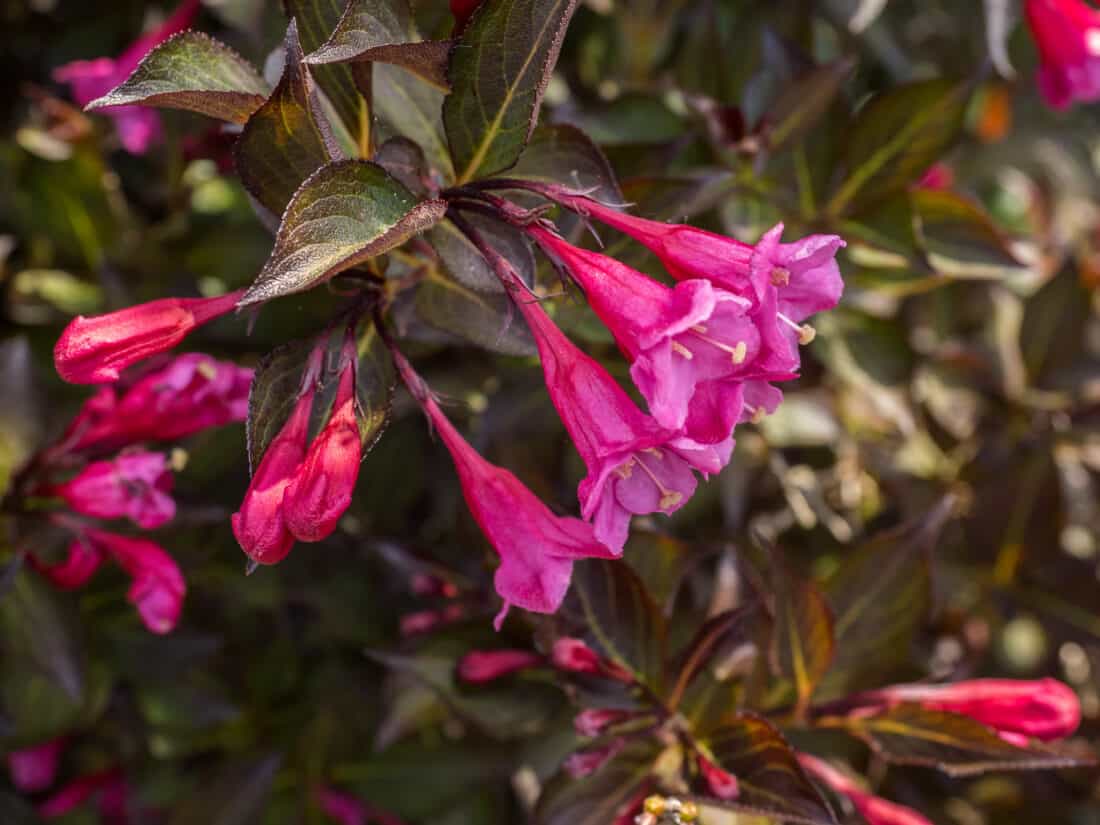
21. Midnight Wine Weigela (Weigela florida ‘Elvera’):
Midnight Wine Weigela (Weigela florida ‘Elvera’) and other florida varieties are a charming collection of compact deciduous shrubs with ornamental foliage and a profusion of trumpet shaped flowers when in bloom. This variety is known for its deep, burgundy to almost black foliage and contrasting pink tubular flowers that bloom in late spring to early summer. Other Weigela have variegated or green foliage and flowers that range form red to pink to white.
Midnight Wine Weigela is relatively low-maintenance, adaptable to different soil types and resistant to deer damage.
Purchase: Electric Love Weigela
22. Hibiscus Edge fo Night
23 Hibiscus Maple Leaf Hibiscus Acetosella Tea plant Cranberry Hibiscus Burgund
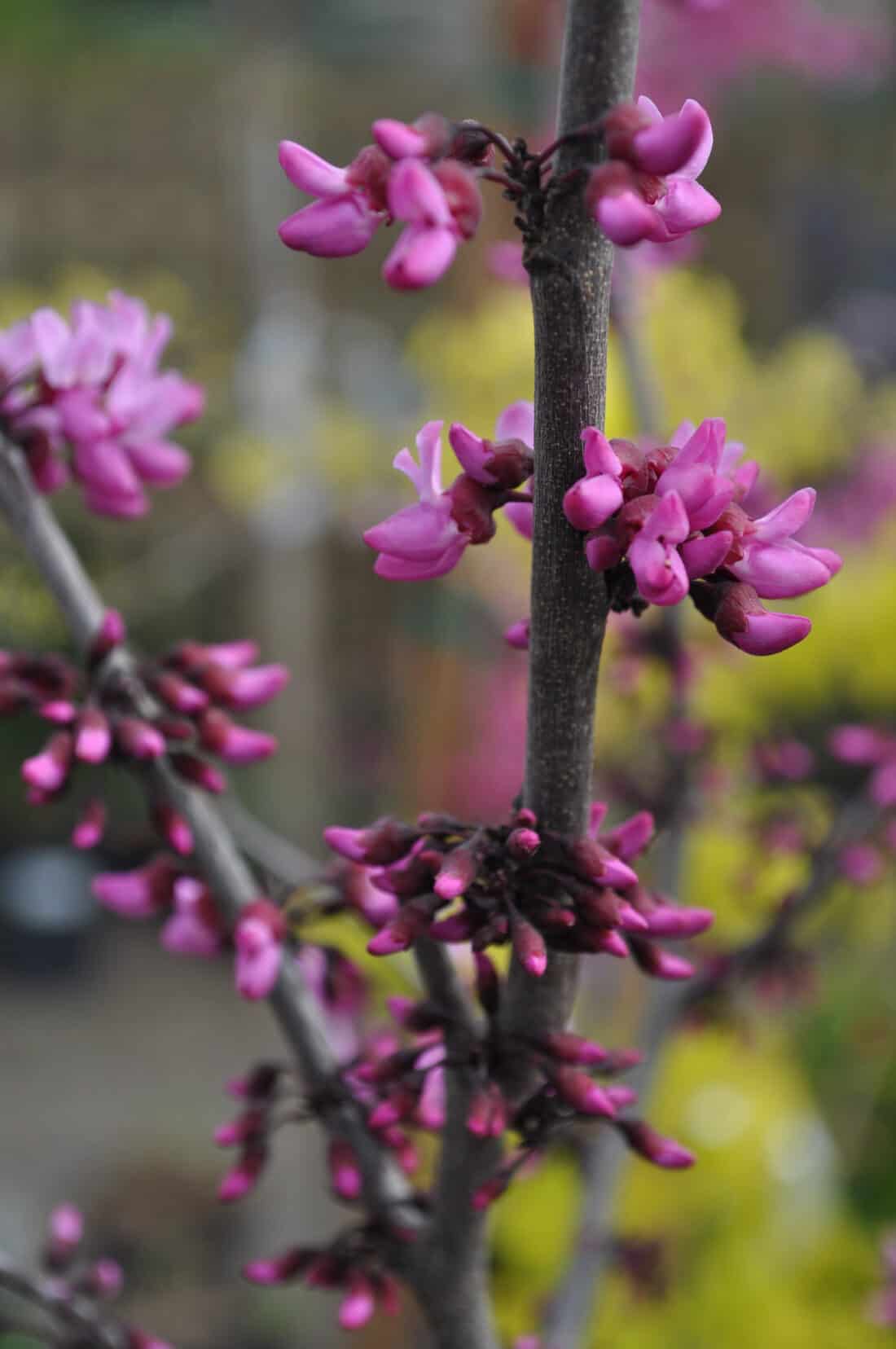
24. Merlot Red Bud (Cercis Canadensis ‘Merlot’)
We love this tree so much, we wrote a whole psot about it – read about Merlot redbud here.
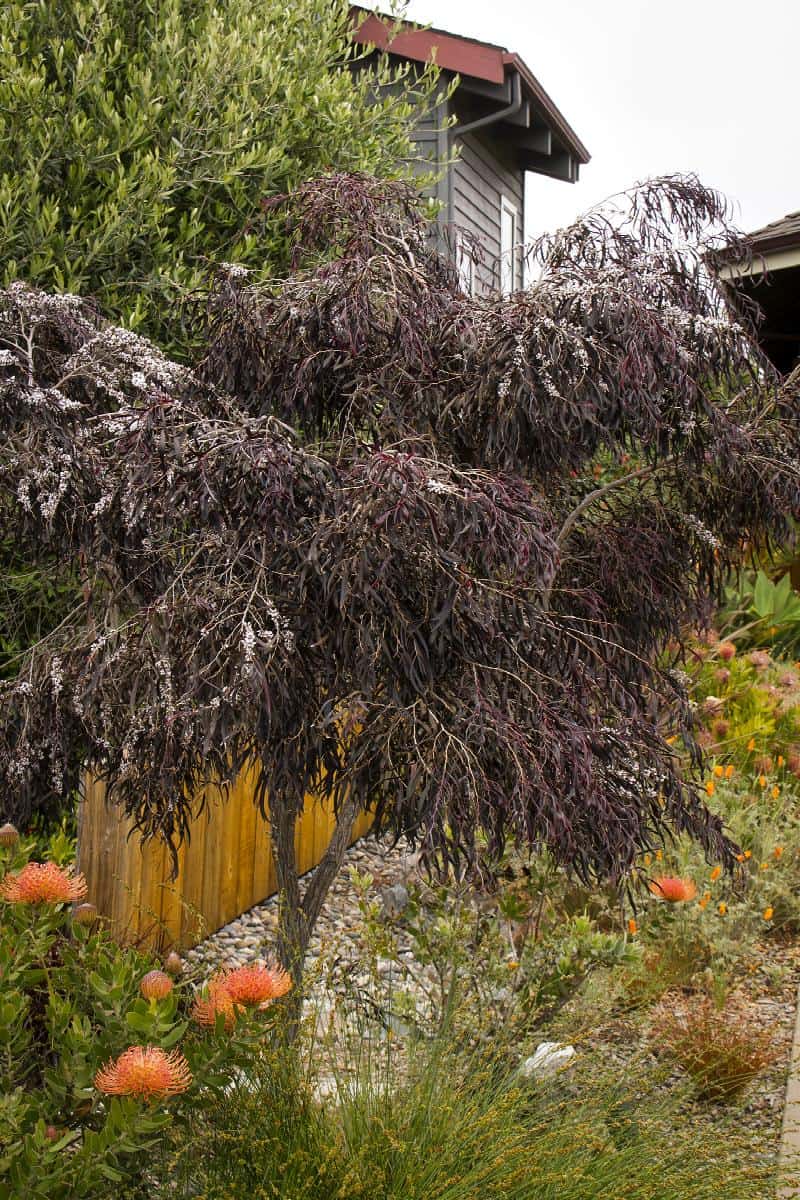
25. Agonis Flexuoso – Peppermint Willow
Agonis flexuosa, commonly known as the Peppermint Willow or Australian Willow Myrtle, is an attractive evergreen tree native to Western Australia. It’s characterized by its graceful weeping branches, slender leaves, and a delightful peppermint fragrance released when the foliage is crushed or brushed against.
The Peppermint Willow is a versatile tree used as a standalone ornamental tree, a screen for privacy, or as part of a mixed planting scheme. Drought-tolerant once established this is only hardy in zones 9-11.
Purchase: After Dark Peppermint Willow
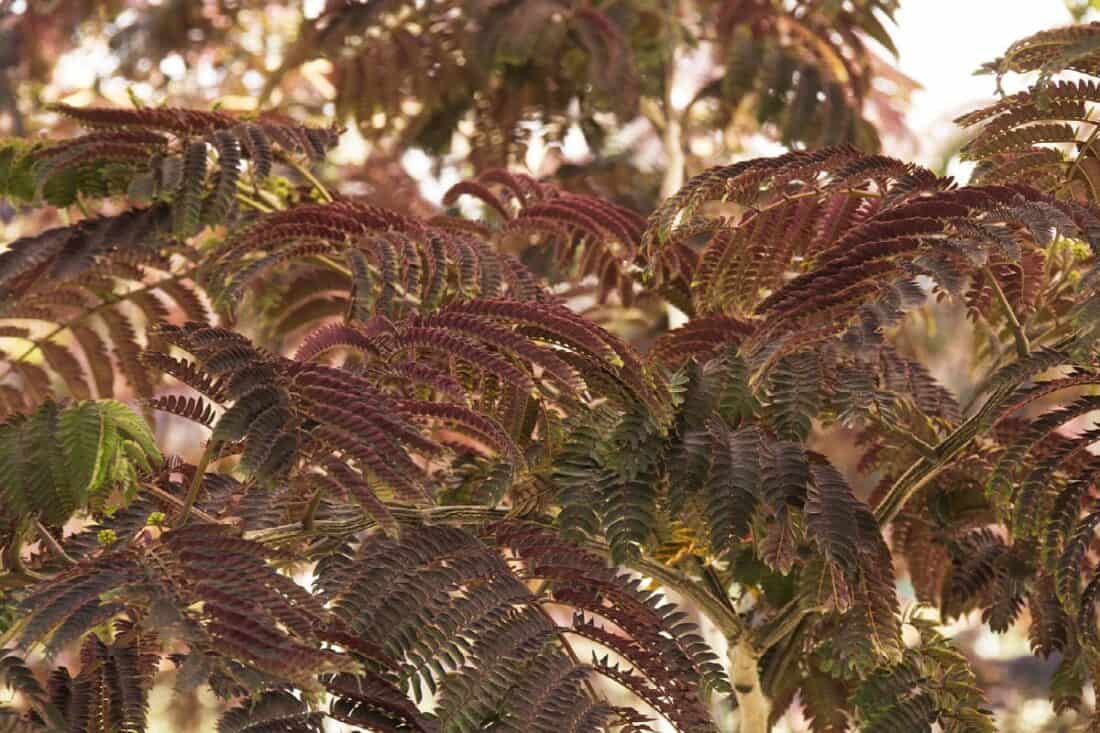
26. Summer Chocolate Mimosa Tree – Albizia julibrissin ‘Summer Chocolate’
Albizia julibrissin ‘Summer Chocolate,’ commonly known as the Summer Chocolate Mimosa or Silk Tree, is a unique and eye-catching deciduous tree for gardeners in warm climates (zone 7-10). It has striking chocolate-purple foliage, which sets it apart from the typical green-leaved varieties of Albizia julibrissin.
This ornamental tree is valued for its fern-like texture and fluffy, pink, pom-pom-like flowers in mid-summer, adding a touch of whimsy to the garden.
Purchase: Monrovia
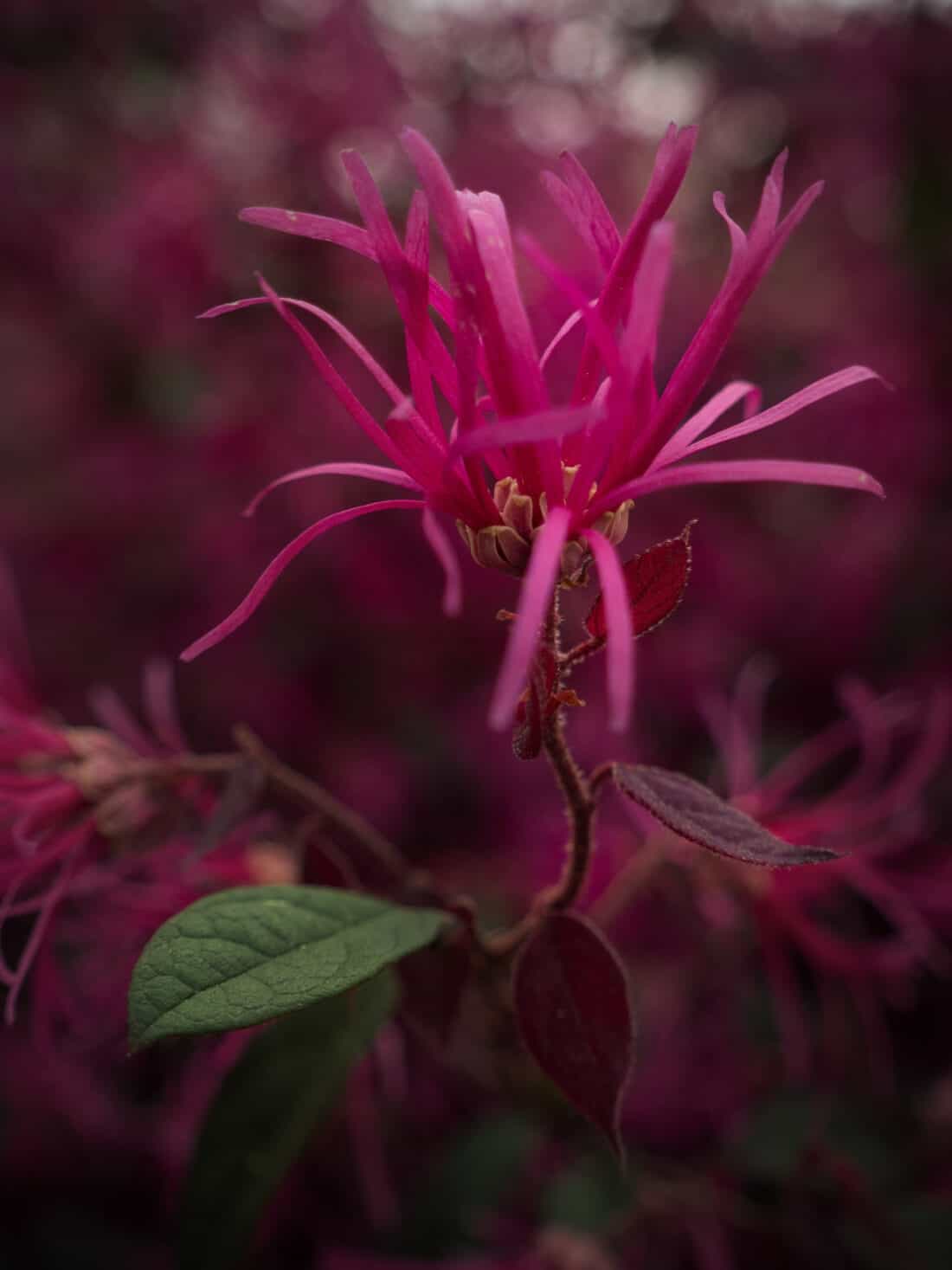
27. Loropetalum – Chinese Fringe Flower
Loropetalum, commonly known as Chinese fringe flower or Loropetalum chinense, is a versatile and visually appealing shrub that comes in various cultivars. It’s native to Asia and belongs to the witch hazel family (Hamamelidaceae).
One of the standout features of Loropetalum is its colorful foliage. Depending on the cultivar, its leaves can range from deep burgundy and rich purple to vibrant green. In addition to its foliage, Loropetalum produces unique and attractive fringed flowers that resemble tiny ribbons in shades of pink, red, or white, depending on the variety.
As a northerner, where this plant is not hardy, I use it small – typically in containers, but Loropetalum is prized for its versatility and can be used in various ways in outdoor garden designs. In southern climates it works well as a foundation plant, hedge, or as a focal point in mixed borders. Its evergreen or semi-evergreen nature ensures year-round interest in the garden.
Purchase : Loropetalum Red Chocolate
Black plants are fashionable, aren’t they? I blogged about my own black plants last week. judywhite’s husband will be writing soon about another author of a book about black plants, I forget her name.
I like the Sambucus ‘black lace’ the best. What a cool plant! I love putting these “black” plants right next to chartreuse and blue plants to really make the colors striking. Thanks for the pics, Susan!
love it – will come back when i am in need of some black plants for my vertical gardens
The color of death…. lovely …I’m DarkLady,,,
ciao dana
Makes my mouth water for some reason. I’m wondering if there is a cultivar name for the black looking purple barberry, or if it is a random barberry that looks black. There must be hundreds of barberrys.
Stunning mosaic of mysterious looking plants, Rochelle.
I particularly like the ephemeral foliage of the species of peony that is dark black/ purply-red as it breaks thru in the spring. Looks great with all the pastels and chartreuse. (P. mlokosewitchii, I think it is)
http://www.hillkeep.ca/images/Paeonia_mlokosewitschii_hybrid_red_IMGP0468x.jpg
Then the foliage greens up and flowers are single pale pink.
Re: plants and winter: some of your readers may be interested in therapeutic garden/herbal gardens- this blog is interesting and inspiring for you..
http://crabappleherbs.com/blog/2007/01/30/winter-flu-care-pink-ginger-tea/
enjoy!
i am not sure black is the color of ‘death & dying’… but very nice site & pics
thanx